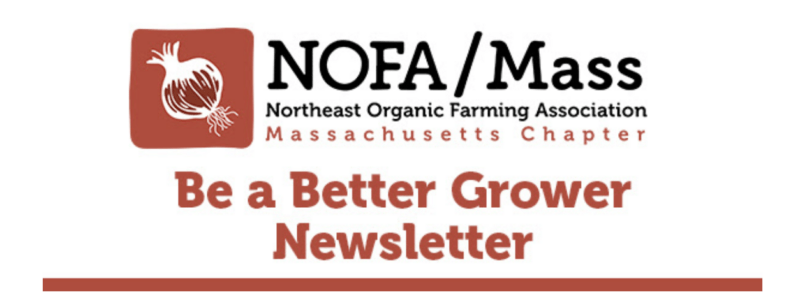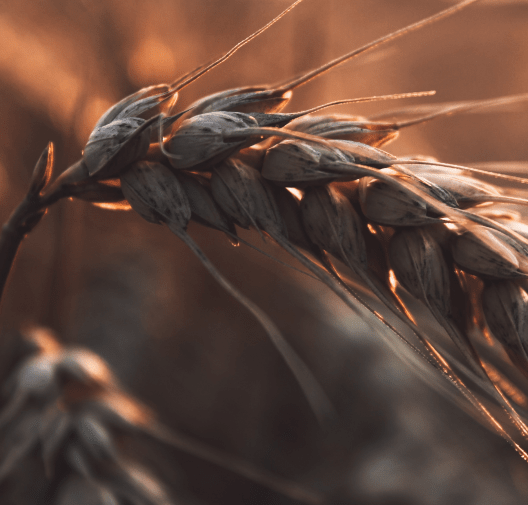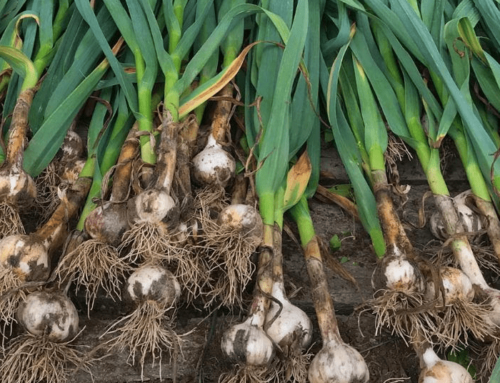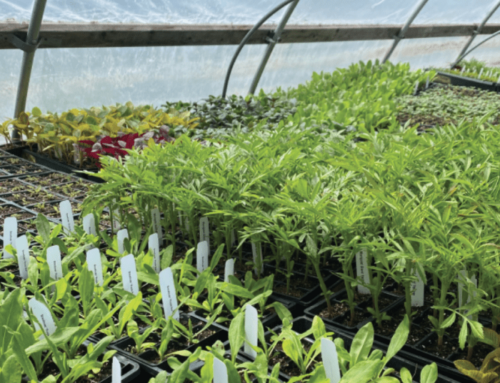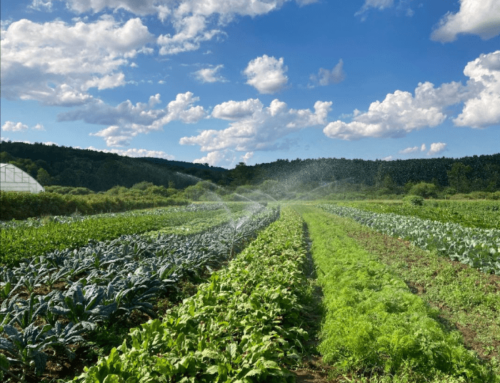Build Your Organic Veggie Vault: Exclusive Insights for Fall and Winter Storage for Your Garden Harvest: An Interview with Pam Dawling
| By: Paul Figueroa, NOFA/Mass Communications Director |
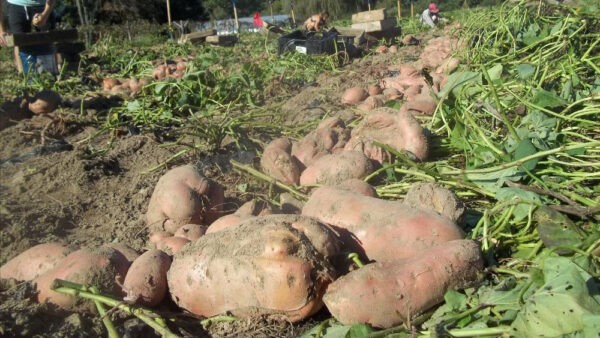
Sweet potato harvest. Photo: Nina Gentle
Pam Dawling has grown vegetables at Twin Oaks Community, central Virginia for thirty years, feeding hundreds of people from 3.5 acres. She is the author of Sustainable Market Farming and The Year-Round Hoophouse. She is a contributing editor with Growing for Market magazine, a workshop presenter, and a weekly blogger on www.
PF: What are the key factors to consider when selecting vegetables for long-term storage during the off-season?
PD: Most of the storable vegetables are roots or tubers. Winter squash, onions and garlic are the main exceptions. And tree fruits such as apples and pears. There are hard-headed storage cabbages too, but those varieties are getting harder to find, as fewer people grow for storage. Search the seed catalogs for the word “storage”. Other varieties are for fresh market, or processing, and won’t store for long.
Choose varieties that are sturdy, chunky, not slender carrots, for instance. Shriveling is related to the ratio of volume to surface area. Ideally, practice the year before growing a very large amount, to see how the variety does in your soil. If it’s too late to do that, try three different varieties and keep records of how they do.
Don’t plan to grow something unless you have the right kind of place to store it! And a likely market. I love celeriac, but it’s not widely known, so I wouldn’t recommend growing lots until you have an idea of the demand.
PF: How can growers maximize the storage life of their off-season vegetables through organic methods, especially as we approach the autumn season?
PD: Storing vegetables is very much a Garbage In-Garbage Out type of thing. If you put unsound vegetables into storage, they will rot and the rot could spread. Good storability starts with good growing techniques, followed by careful harvesting in prime condition, and sorting for storability. Some crops need curing before storing (alliums, peanuts, sweet potatoes, white potatoes).
During growth, fend off any serious pest predation, as crops with holes in may not store well. Be sure you know the temperature at which each crop will suffer cold damage, and get it harvested before that happens.
Harvest when the crops are optimum size and in peak condition. Ideally, harvest in dry weather. Handle the vegetables gently. Bruises can happen invisibly, so if you drop something, don’t store it. Look each vegetable over and only store ones without soft spots or deep holes. Carrots or sweet potatoes snapped in half can heal over and store just fine, but stabbed potatoes won’t. Superficial bug bites will heal over but not tunneling.
For traditional storage without refrigeration, most roots store best unwashed (less wrinkling). This can make them harder to clean later. We prefer the modern alternative of perforated plastic bags, which reduce the water losses that lead to wrinkling.
If you are going to store root crops unwashed, consider setting them in a single layer on the field and making a second trip round to pick them up into crates when the skins are dry. If you are going to wash them, the opposite is true! Get them into water before the skins dry, to help the washing go quicker. We don’t wash sweet potatoes, white potatoes or squash. We do wash all the other root crops, as it’s harder to get them really clean if the soil dries on them. Provided you store them in humid enough conditions, they will not shrivel.
Small roots won’t store well. We have a “training tool” for new crew members which is a bucket lid with holes cut in it. If the carrot can pass through the carrot hole, it’s too thin to store well. Potatoes less than about an inch are not worth storing. Likewise tiny turnips.
White potatoes can reach a storable state two weeks after the tops die in the field. If you are in a hurry, mow the tops off, then wait two weeks. Check that the skins are “set” and don’t tear if you rub the potato with your thumb.
Trim leafy tops from root vegetables, leaving very short stems on beets and carrots. During long storage, the stubs of leaf stems may die and drop off, but this is nothing to worry about. If you cut the tops off beets completely, the red color will wash out during cooking. Definitely don’t cut into the root part of beets when trimming. Some people trim the long ends of beet roots, but I never have. They don’t take up much space! I trim the roots from kohrabi, and for that task, I cut into the bulbous part of the root, as the skinny root has such a high concentration of fibers that it’s like a steel cable! The cut surface soon heals over.
Tops of garlic and onions can be trimmed after the crops have cured and the leaves died. Making braids or ropes of alliums with their tops on can be a profitable option.
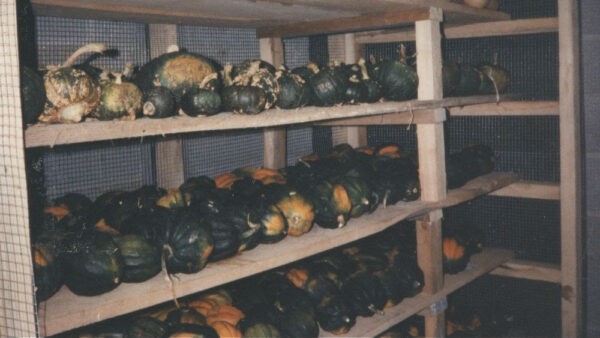
Winter Squash Storage, Twin Oaks Community
PF: What are the most suitable storage methods for different types of vegetables, such as root crops, leafy greens, and fruits, to maintain freshness?
PD: In my book, Sustainable Market Farming, I have a whole chapter on Winter Vegetable Storage. Growers have only good things to say about the CoolBot system from Store-It-Cold. Basically, you build a well-insulated space (shed, room, truck body), buy a window AC unit and the CoolBot and follow their excellent instructions to install the device which lets you run the AC at a lower temperature, like a refrigerator, at a fraction of the cost.
Be sure to have a thermometer hanging in your storage spaces, so you know when to warm or cool them. Digital thermometers might measure humidity too. You can get a little electronic device that will send an alert to your phone if the temperature goes too far out of range.
For storing white potatoes without refrigerators, the best place is a root cellar. You are aiming for cool and moist conditions: 40-50°F (5-10°C), with 85-90% humidity. You really don’t want to store potatoes below that range, or they go black when you make fries.
Most other vegetables fit into four other sets of storage conditions:
-
Cold and Moist (33-40°F/1-4°C, 95-100% humidity, works for most root crops, and also cabbage, Chinese cabbage, kohlrabi and leeks.
-
Cool and Moist is mostly potatoes, as I already mentioned. Pears, apples and cabbage also store well in these conditions but not sharing space with potatoes! More on that later.
-
Cool and Dry is for garlic and onions. 32-40°F/0-4°C and 60-70% humidity. It’s also possible to store alliums warm and dry at first, 65-85°F/18-30°C, but definitely not 40-56°F (4-13°C) for garlic, or 45-55°F (7-13°C) for bulb onions or they will sprout. Never warm after cold either.
-
Warm and Dry to Fairly Moist is for winter squash and sweet potatoes. Never below 50°F (10°C). Ideal temperature 55-59°F (13-15°C). Temperatures above 65°F (18°C) hasten sprouting. Also ripening green tomatoes like 55-70F/13-21C and moist (75-85%).
For the warmer options, barns or basements might be suitable in the fall, before they get too cold. There are also traditional in-ground storage methods, such as clamps, pits and trenches. The easiest version of this, in the right climate, is to mulch heavily with about 12” (30 cm) of insulation (such as straw, dry leaves, chopped corn stalks, or wood shavings) over the row, and maybe add low tunnels over the mulch.
Clamps are made by setting down a layer of insulation on the ground, piling up the crops in a rounded cone or ridge shape, covering thickly with straw, then working round the mound digging a ditch and slapping the soil up on the mound. Pits and trenches start by digging a hole, lining it with straw or an old chest freezer, layering in the vegetables with straw and covering with boards and a thick layer of insulation. Insulated boxes stored in unheated areas need 6-8” (15-20 cm) of insulation on the bottom, sides, and top. This all takes a lot of work, so look into the CoolBot idea first! If you are planning a new barn, consider installing an insulated basement to be a root cellar.
PF: Are there specific containers or packaging materials that are best for preserving vegetables in the off-season?
PD: We use perforated clear plastic sacks for roots, cabbages and kohlrabi; net bags for onions and garlic; plastic milk crates for potatoes; folding plastic crates for squash and sweet potatoes. We leave horseradish, Jerusalem artichokes and leeks in the ground here in zone 7a, but we don’t get frozen soil for much of the winter. In Massachusetts you’d probably be wiser to dig and store them. We don’t use any packaging materials, but in England in the past I stored roots in boxes of damp peat moss, sawdust, sand or wood ash. I find it better to get the right storage conditions for the vegetables, rather than try to insulate them in their crates.
Set the containers on pallets, not directly on concrete floors, to reduce condensation. The stacking of your containers should allow for airflow, but you don’t want the produce to shrivel up, so be observant. Celeriac needs more ventilation than beets or kohlrabi, for instance. Sometimes night ventilation offers cooler drier air than you can get in the daytime. Keeping root cellar temperatures within a narrow range takes human intervention, or sophisticated thermostats and vents. If needed, electric fans can be used to force air through a building.

Approximately 10,000 pounds of potatoes in our root cellar. Photo: Michael at Twin Oaks
PF: Are there any vegetables that are particularly challenging to store long-term, and do you have any specialized tips for these varieties?
PD: Read the small print in the seed catalogs! Moschata winter squashes such as butternuts, Long Island Cheese and Seminole store all winter, but acorn squash do not. You can store acorn squash for a couple of months, but then move them along to people’s dinner plates.
Sweet potatoes must be cured before storage. This means hot humid conditions until the skins don’t rub off when you rub two together. After that you can move them to storage conditions (or turn down the heater and humidifier!) It is important that sweet potatoes never go below 50°F (10°C) or they will suffer a permanent chilling injury that makes them almost impossible to cook. I know because I’ve made that mistake, leaving them in the ground too long, hoping they’d grow bigger.
White potatoes can be challenging: they also need to cure until the skins toughen, in moist air (90% humidity) for 1-2 weeks at 60-75°F (15-24°C). Wounds in the skin will not heal below 50°F (10°C). We sort our potatoes after two weeks of curing and find that sorting at this point usually reduces the chance of rot so that we don’t need to sort again. Remember to keep white potatoes in the dark while curing as well as during storage.
They need to stay moist so they don’t wrinkle. They have fairly exacting temperature requirements so they don’t sprout.
Some vegetables exude ethylene in storage: fruits, damaged produce, sprouting vegetables. Some crops are not much affected by ethylene (greens for example) and can be stored in the same space with ripening tomatoes, for instance. Other vegetables, however, are very sensitive to ethylene, and will deteriorate in a high-ethylene environment. Potatoes will sprout, ripe fruits will go over the top, carrots lose their sweetness and become bitter. When storing ripe fruit, ventilate with fresh air frequently, maybe even daily, to reduce the rate of over-ripening and rotting. Ethylene also hastens the opening of flower buds and the senescence of open flowers.
PF: Can you provide some insights into extending the shelf life of homegrown vegetables without using artificial preservatives or chemicals?
PD: When you have choice in the matter, try to harvest roots from relatively dry soil, so they are less likely to grow mold.
For non-refrigerated storage, unless using outdoor pits or clamps, several smaller containers of each crop are often a safer bet than one giant one, in case rot sets in.
For crops that store best at 32°F (0°C), if you can only store them in warmer temperatures (up to 50°F/10°C), expect to get about half the storage life they’d last for in ideal conditions, provided they do have high humidity. Alliums like it a bit drier, and see my warning about the “danger zone” sprouting temperatures. You may be able to reallocate crops to some colder spaces as some of the original produce stored there gets used. Make a realistic assessment of how long your crop will last in the actual conditions you are providing, and plan to move them all on before then.
After you’ve put your produce into storage, don’t completely forget about it! Keep a record of what is stored where and perhaps a check sheet for inspection. Monitor the rate of use and notice if you’d benefit from more or less of each crop next winter.
Regularly check the storage conditions are still meeting your goal, and check through the crops at least once a month, removing the bad ones. Shallow crates make this easier. For root crops and squash, and maybe alliums, the initial storage period is the most likely to show up trouble. Later the crops become more dormant, and less change happens.
After long storage, some vegetables look less than delicious, and benefit from a bit of attention before the diners get them. Cabbage can have the outer leaves removed, and can then be greened up by exposure to light for a week at 50°F (10°C). This isn’t just cosmetic – the vitamin C content increases tenfold. Carrots can lose their sweetness over time, unless frequently exposed to fresh air, by ventilating well.
Special thanks to Pam Dawling for participating in this interview for NOFA/Mass. If you would like to learn more practical growing tips please follow our Ed Events page and Winter Conference page on the NOFA/Mass website for updates on our upcoming events and conference.



